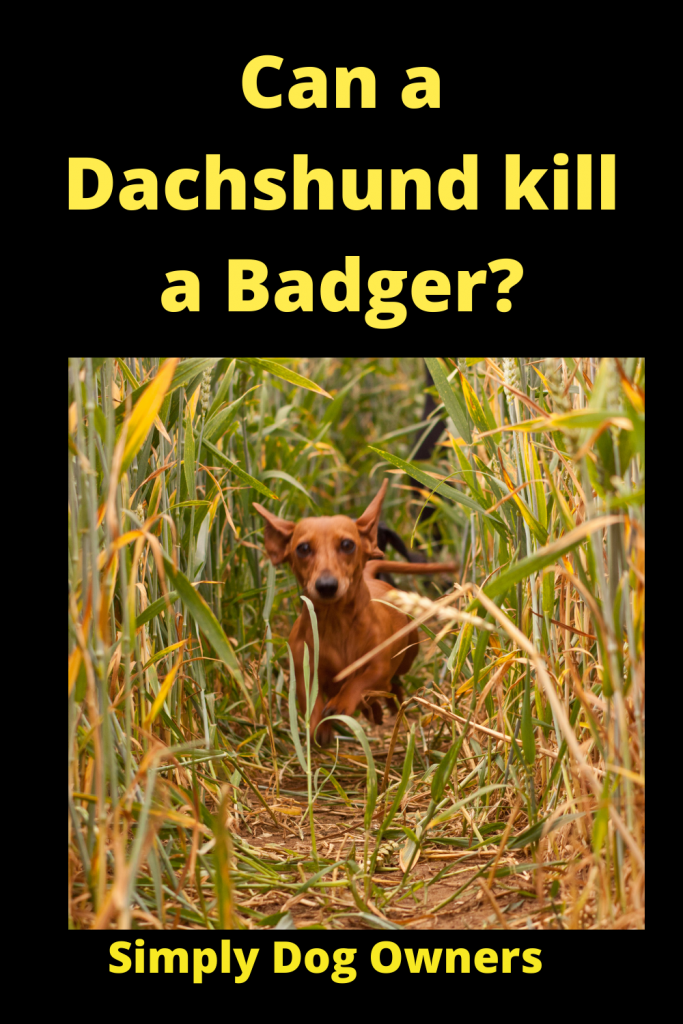Can a Dachshund Kill a Badger? (Dachshund Hunting Badger)
Can a Dachshund kill a badger? Do you know that the German word for badger dog is Dachshund? Dachshunds were bred to hunt badgers, and they’ve proven to be the best at what they do, literally. For this reason, the AKC has designated them as the only breed suitable for both on-ground and underground hunting.
Hunting was once more a necessity than a recreational activity. Germans discovered that hunting smaller prey was more accessible than hunting larger prey during this period. They were, however, difficult to capture. Can a Dachshund Kill a Badger? (Dachshund Hunting Badger)
As a result, the hunters required a dog to borrow down the holes and bring prey out without fear. As a result, they created Dachshunds. They were ideal for the job because of their fearlessness, small bodies, and incredible stamina.
When dachshunds reach their prey underground, they concentrate on dragging it out of the burrow rather than killing it. It would be difficult for a dachshund to kill a badger on its own because badgers have thick fur that protects their necks.
Traits That Make Dachshunds Incredible Hunters
Some of the characteristics that made dachshunds great badger hunters are listed below.

Strong Sense of Smell
Dachshunds are referred to as “scent hounds.” Dachshund’s sense of smell is out of this world, with 125 million scent receptors and an olfactory bulb 40 times the size of a human’s. I’m not convinced yet. What’s more, dachshunds can detect odors that are up to a week old!
While their large ears assist in sweeping the ground to bring scent to their noses, their dewlaps, the loose skin under their chins, aid in trapping and maintaining scent as they seek prey. When it comes to hunting underground, their exceptional sense of smell gives them an advantage. In a matter of seconds, dachshunds bring badgers out of hiding. Their long noses also aid in detecting odors from great distances.
Dachshunds are exceptional at tracking scent trails. As a result, hunters could rest assured that badgers attempting to flee would be found. They also assisted in the tracking of blood to locate injured prey. Picking up a scent is one thing; staying on track with it, especially when there are other scents in the vicinity, is another.
Despite the confusion, well-trained dachshunds may be able to follow the original scent and pursue the prey. As a result, dachshunds are now used for blood tracking missions to locate victims during natural disasters such as hurricanes, in addition to hunting.
Bravery
Badgers are among the most dangerous prey for dachshunds to hunt. In some cases, the dog is injured or, in the worst-case scenario, killed. The bravery and aggression of dachshunds, on the other hand, come in handy here. They bravely dig their way underground to the badger’s hideout.
Hunters would sometimes bring more than one Dachshund to gain an advantage over badgers. The dogs would confidently surround and corner the prey, completely immobilizing it. Badgers can be aggressive and defensive at the same time.
They fight back, focusing their efforts on their necks more than any other part of their bodies. This, however, is insufficient to deter the Dachshund. A dachshund is determined to catch the prey and will not stop until the same is in the hunter’s hands.
Dachshunds also have powerful jaws and strong teeth at the front of their muzzles to immobilize prey and keep it away from their torsos to avoid fatal injuries. A dachshund’s level of aggression causes it to go after prey that is three times its size! It’s no surprise, then, that dachshunds kept as pets can be aggressive toward strangers and other pets. This is a good hunting trait, but it could be dangerous at home. It’s in their nature, but you’ll benefit from consistent training.
Intelligence and Independent Thinking
Dachshunds have a high level of intelligence, which makes them ideal human companions. They are perfect badger hunters because of their ability to distinguish between prey and other animals. Even without a command from the hunter, Dachshunds would react quickly when they saw prey.
They pursued the prey alone, and even after catching it, they knew it wasn’t their job to kill it but instead to corner it so the hunter could make the kill. Because of their intelligence, they are easier to train. Their independence, on the other hand, makes the process difficult. It’s not easy to fight instincts, and this is one of them.
When hunting, Dachshunds also know when to be quiet, which gives them an advantage over prey. They followed the trail in silence until they reached it. Isn’t it amazing how much dachshunds enjoy working together? When hunting with a large group of dogs, one would chase the prey to its nest, another would drive it out, and the remaining dogs would immobilize it until the hunter could call the final shots.
Endurance
On the hunt, you can’t trade a dachshund’s incredible stamina for anything. Their strong prey drive would make them fantastic hunters both above and below ground. Dachshunds are tenacious dogs. Badgers and other prey would be pursued for as long as it took. They could go to the deepest part of the bushes with minimal injuries because of their tiny bodies.
The dogs’ small bodies also help them keep a low center of gravity when chasing prey in sloppy areas, as their short legs allow them to burrow underground and corner prey. Their paddle-like paws assisted in digging for prey for hours in the barrows.
Furthermore, their deep chest and long back allow them to have larger lungs, which gives them more stamina when hunting.

As a result, dachshunds can breathe while inside the barrows. The Dachshund’s larger lung capacity also allows him to maintain a constant energy supply during his never-ending hunt for prey. Is that all there is to it? No, it’s not true.
Their tiny bodies, long backs, and large lungs allow them to run quickly on the hunt, making them valuable assets. They can be obstinate as pets, barking incessantly, digging up your lawn, and so on. It’s not easy to fight this instinct. Things can, however, improve with perseverance and proper training.
Dachshunds Are Loud Barkers
The barks of dachshunds are one of their most notable features. Dachshunds are known for their loudness. Their barks are loud due to their tiny bodies and large lungs. For a variety of reasons, they will bark. When bored, depressed, anxious, excited, or, most importantly, in a stranger encounter.
During a hunt, their loud barks were proper. They barked to warn the hunter that there was a threat and that prey was nearby. They also used their barks to scare away dangerous prey.
Because they are territorial, any threat to their peace or the hunters would be met with a bark. Their barks also assisted in locating them if they became separated from the hunter. Is your Dachshund excessively barking? Relax. He’s simply trying to communicate that he’s content, hungry, bored, or doesn’t want you to leave. Determine what it is and provide it with the necessary training.
Undying Loyalty
For the longest time, dogs and humans have had a good relationship. According to historical and archaeological evidence, dogs may have been the first animals kept as pets by humans. The story of Dachshunds is similar. Since their origins in Germany in the 1500s, Dachshunds have had a close relationship with humans.
They’ve been loyal to man the whole time, which is an essential trait in hunting. A dachshund would follow the hunter and his pack during a hunt. They would jealously guard the hunter from any on-the-field dangers. They obediently obeyed the hunter’s command when taken out to hunt badgers and other prey.
On the field, their primary focus is on the prey, and they are unstoppable in this regard. They’d catch something and deliver it to the hunter. They regard the hunter as their superior and thus follow him around and obey his orders.
Dachshunds have remained loyal to this day. If you have a dachshund as a pet, you’ve probably noticed how devoted he is to a specific family member, who may have adopted him or fed him first. They form a strong bond with this person, which they jealously guard.
Curiosity
You might think cats are the only curious pets, but you’d be wrong. Dachshunds are as well, which makes them excellent hunters. Dachshunds are unafraid of trying new things. Dachshunds would sniff and dig until they found prey, and once they did, they would stop at nothing until it was in the hands of the hunter.
You’ve probably noticed how daring dachshunds can be if you have one. It will suffice to take a few short walks. You’ll see that your Dachshund gets jumpy when you take him out. While sniffing, I’m rushing from one location to another. Controlling him can be challenging at times.

What do most Dachshunds Die From?
Among dachshunds, there are a few common causes of death. Cancer, heart disease, liver disease, and kidney disease are among them. Cancer (neoplasia) is the leading cause of death in older dachshunds, according to studies.
The second leading cause of death in dachshunds is heart disease. Heart disease affects nearly 10% of the population. The incidence of heart disease in dachshunds rises dramatically as they get older. Liver disease is the next leading cause of death in dachshunds. However, depending on the cause, severity, and overall health of the dog, the symptoms and life expectancy of dogs with liver disease can vary significantly.
Kidney disease is another common cause of dachshund death. The kidneys are responsible for balancing certain substances in the blood and removing waste. Accumulated toxins essentially poison the body if the kidneys fail and the blood is not filtered.
Kidney failure can be produced by various factors, including kidney stones, toxin ingestion, bladder rapture, urinary obstruction, infection, or aging. Kidney disease can be caused by advanced dental disease. Bacteria that cause tooth decay to enter the bloodstream and damages the liver, kidneys, and heart irreversibly.
Bloat, old age, immune-related diseases, Addison’s disease, and seizures are other causes of death.
What were Dachshunds Badgers Bred for?
They’d been bred to go after Badgers. The Dachshund’s official origins can be traced back to the 15th century in Germany, where two dachshunds were produced mainly for hunting. The Miniature Dachshund was bred primarily for hunting rabbits, while the Standard Dachshund was bred primarily for smelling and flushing out badgers and other burrow-dwelling mammals. In the United States, dachshunds have also been used for hunting prairie dogs and tracking deer.
The name Dachshund is obtained from the German words “Dachs” and “Hund.” It means “badger dog.” The Dachshund is more commonly known in modern Germany as Dackel or Teckel, with Teckel being more prevalent among hunters. Because of their long, slender, sausage-like body and build, Dachshunds are also known as wiener dogs or sausage dogs.
The paddle-shaped front paws of dachshunds aid them in any ‘extreme’ digging, which is particularly useful when hunting and racing badgers, rabbits, and other mammals. When hunting underground, the Dachshund’s deep chest can provide the dogs with increased lung capacity.
Dachshunds are thought to have evolved from dwarf mutations of taller hunting hounds such as the Schweisshund (bloodhound) and Bibarhund. To make perfect breed for going down holes for Badgers and Rabbits, hunters gradually shortened their legs through selective breeding.
What Animals will Dachshunds Hunt?
Dachshunds are scent hound dogs that have been bred to hunt badgers, rabbits, and foxes. On the other hand, miniature dachshunds can hunt rabbits, pheasants, mice, and small birds. In the Western United States, dachshunds are also known for hunting prairie dogs.
Standard and miniature dachshunds are the two main types of long-bodied and short-legged dachshunds. Miniatures primarily hunt smaller animals. They are most attracted to fast-moving, short animals. Dachshunds become ferocious once they have caught the target animal.
At home, they may be playful and obedient. Once they’re outside, their hunter instincts kick in. They have an instinct for digging. You’ll see them digging or burrowing for target animals while hunting. They also have a natural prey drive.
How do Dachshunds Hunt Badgers?
The dogs accompanied the foresters on their hunting trips until burrowing prey such as badgers were spotted. When the prey went underground, one or more dachshunds were dispatched to pursue them, often through multiple underground burrow entrances. If given the opportunity, they will attack other, much larger animals.
The short-haired dachshund dog is well-suited to close-quarters combat in the burrow. His teeth are razor-sharp and protrude from the front of his long muzzle. The Dachshund’s jaws are strong and deliver an immobilizing bite, keeping the prey away from the Dachshund’s vulnerable torso. For staying power, the neck is muscle-corded.
The smooth, loose coat of the short-haired Dachshund is difficult to bite and hold. Because the dog’s lungs expand front to back inside the rib cage, there’s no risk of being trapped or hampered by chest expansion in a tight tunnel.

Long-term stamina is linked to a large lung capacity. Their short front and back legs also have digging claws, and their paws expand into a spade-like shape when under pressure, allowing them to move the earth. They have both trail (following the scent of prey) and reverberatory senses, just like all hounds.
When dachshunds arrive underground, they concentrate on dragging the prey out of the burrow rather than killing it. A badger is also adapted for defense, with heavy fur protecting the neck, so it would be difficult for a dachshund dog to kill one on its own. However, the Dachshund’s job is to drag the badger out of his burrow, not fight him to death.
Risk for Dachshunds while Hunting Badgers.
Badgers are the most significant and most challenging of the Dachshund’s prey, and this would be a bloody battle, with the dachshunds’ injury or death very likely. The foresters would have bred their small fighters in large numbers, expecting to lose some dogs in battle.
The eradication of dangerous and damaging pests from cultivated grounds and domestic woods of medieval and feudal Germany was the Dachshund’s raison d’etre, so the prince could enjoy his land and more elevated forms of hunting with his guests. By far, badgers would be more easily dispatched than groundhogs and rodents.
It was common in the field for several dogs to work together to drag and immobilize a badger by pulling it in different directions. Once out in the open, the hunter would be responsible for dispatching the prey and skinning it, and feeding it to the dogs to increase their interest in this type of hunting.
Dachshunds Care
Dachshunds have a lot of strength and stamina. They enjoy going for walks or playing outside with other dogs, as well as hunting and digging. They are also active indoors and can live comfortably in small spaces if they moderate daily exercise. Aim for two half-mile walks per day (each lasting about 10 minutes). When time is limited, a game of fetch will satisfy their need for activity.
They should not be kept outside or in a kennel but rather in the house. Jumping on and off furniture can injure Dachshunds’ backs, so get a ramp or some steps and instruct them to use it if they want to get up on the sofa or bed. Always support a Dachshund’s back and chest when you’re holding him.
If suitably motivated, Dachshunds can learn quickly. To keep their attention and keep training sessions short, use positive reinforcements like food rewards or a favorite toy. If the Dachshund dog is repeatedly forced to repeat the same exercise, he will become bored quickly, making obedience training fun and interesting for him.
With this breed, housetraining can be a challenge. A Dachshund dog may not see the need to go outside to relieve himself. Patience and perseverance are required. Crate training is also beneficial.
In addition to housetraining, crate training is a gentle way to keep your Dachshund dog from getting into things he shouldn’t. Dachshunds, like all dogs, can be destructive as puppies. Crate training your Dachshund puppy from a young age will help him accept confinement if he ever needs to be boarded or hospitalized.
However, never leave your Dachshund dog in a crate all day. It’s not a jail, and he shouldn’t stay in it for more than a few hours at a time unless he’s sleeping. Dachshunds are people dogs who should not be confined to a crate or kennel for the rest of their lives. Although the Dachshund is an excellent watchdog, he can be noisy. Minis, in particular, are prone to yapping. If your Dachshund dog is living in an apartment or condo complex, keep this in mind.
Dachshunds FAQ
Do you have a Dachshund and have questions about them? This FAQ is for you! We will answer some of the most common questions that Dachshund owners have, such as how to train them, what to feed them, and more.
Are Standard Daschunds Good Hunting Dogs?
Dachshunds were bred to hunt badgers and other burrowing animals, so they do have a natural instinct to hunt. However, not all Dachshunds make good hunters – it depends on the individual dog’s personality and hunting instincts.
Are Dachshunds able to Hunt Wild Boar?
Dachshunds are bred to hunt small prey such as badgers and rabbits, so they would not be effective at hunting wild boars. They would not be able to be used to hunt Wild Boar for the following reasons
- Size – Dachshunds are smaller in size than wild boars, so they would not be able to take them down.
- Short Legs – Their short legs make it difficult for them to run after prey for long distances.
- The aggressiveness of Wild Boar – Wild boars can be very aggressive and can easily overtake a Dachshund.
- A standard Dachshund can be an effective hunting dog for small game, such as rabbits and hares. They are also known to be good at hunting vermin, such as rats and mice.
Where did Dachshunds get the Nickname Weiner Dogs?
The nickname “weiner dogs” is most likely derived from the German word “wienerschnitzel”, which means veal cutlet. In the United States their resemblance to an Oscar Meyer wiener has caused them to be commonly called “wiener dogs”.
Where did Dachshunds get the Title sausage Dogs?
The title “sausage dogs” is most likely derived from the German word “wurst”, which means sausage. The sausage was a popular food in Germany during the time when Dachshunds were first being bred, because of their length and appearance,so the name may have just been a way to describe the breed. Thanks for reading!
Final Thoughts
There’s no denying that Dachshunds were and still are excellent hunters. Badgers’ worst enemy are these brave, curious, intelligent, loyal hunters with an incredible sense of smell. The personalities of today’s dachshunds have made them adorable pets who make excellent human companions. Get yours one now!
